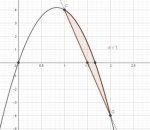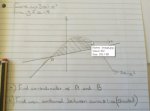Ok,
If i want to find the area enclosed between y = -6x^2+18x-12 and the x axis. I can integrate between x=1 and x=2 and answer equals 1.
If i now think about the area enclosed between y= -6x^2+10x and the line y= -8x+12, from the reasoning above algebraically this should be the same answer as above between x=1 and x=2. But looking at it graphically i have an area above and an area below the x axis , that doesn't seem to make sense to me?
Does this make sense to anyone??!!
If i want to find the area enclosed between y = -6x^2+18x-12 and the x axis. I can integrate between x=1 and x=2 and answer equals 1.
If i now think about the area enclosed between y= -6x^2+10x and the line y= -8x+12, from the reasoning above algebraically this should be the same answer as above between x=1 and x=2. But looking at it graphically i have an area above and an area below the x axis , that doesn't seem to make sense to me?
Does this make sense to anyone??!!




